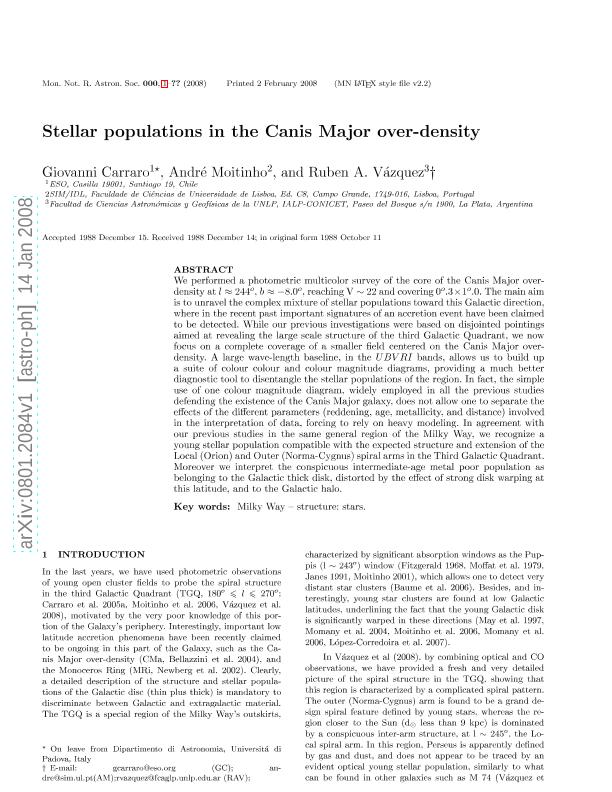Mostrar el registro sencillo del ítem
dc.contributor.author
Carraro, Giovanni
dc.contributor.author
Moitinho, André
dc.contributor.author
Vazquez, Ruben Angel

dc.date.available
2018-05-07T17:27:57Z
dc.date.issued
2008-12
dc.identifier.citation
Carraro, Giovanni; Moitinho, André; Vazquez, Ruben Angel; Stellar populations in the Canis Major overdensity; Wiley Blackwell Publishing, Inc; Monthly Notices of the Royal Astronomical Society; 385; 12-2008; 1597-1604
dc.identifier.issn
0035-8711
dc.identifier.uri
http://hdl.handle.net/11336/44320
dc.description.abstract
We performed a photometric multicolor survey of the core of the Canis Major overdensity
at l ≈ 244o, b ≈ −8.0o
, reaching V
∼ 22 and covering 0
o
.
3
×
1
o
.0. The main aim
is to unravel the complex mixture of stellar populations toward this Galactic direction,
where in the recent past important signatures of an accretion event have been claimed
to be detected. While our previous investigations were based on disjointed pointings
aimed at revealing the large scale structure of the third Galactic Quadrant, we now
focus on a complete coverage of a smaller field centered on the Canis Major overdensity.
A large wave-length baseline, in the UBV RI bands, allows us to build up
a suite of colour colour and colour magnitude diagrams, providing a much better
diagnostic tool to disentangle the stellar populations of the region. In fact, the simple
use of one colour magnitude diagram, widely employed in all the previous studies
defending the existence of the Canis Major galaxy, does not allow one to separate the
effects of the different parameters (reddening, age, metallicity, and distance) involved
in the interpretation of data, forcing to rely on heavy modeling. In agreement with
our previous studies in the same general region of the Milky Way, we recognize a
young stellar population compatible with the expected structure and extension of the
Local (Orion) and Outer (Norma-Cygnus) spiral arms in the Third Galactic Quadrant.
Moreover we interpret the conspicuous intermediate-age metal poor population as
belonging to the Galactic thick disk, distorted by the effect of strong disk warping at
this latitude, and to the Galactic halo
dc.format
application/pdf
dc.language.iso
eng
dc.publisher
Wiley Blackwell Publishing, Inc

dc.rights
info:eu-repo/semantics/openAccess
dc.rights.uri
https://creativecommons.org/licenses/by-nc-sa/2.5/ar/
dc.subject
Galaxy
dc.subject
Evolution
dc.subject
Structure
dc.subject
Galactic Halo
dc.subject
Milky Way
dc.subject.classification
Astronomía

dc.subject.classification
Ciencias Físicas

dc.subject.classification
CIENCIAS NATURALES Y EXACTAS

dc.title
Stellar populations in the Canis Major overdensity
dc.type
info:eu-repo/semantics/article
dc.type
info:ar-repo/semantics/artículo
dc.type
info:eu-repo/semantics/publishedVersion
dc.date.updated
2018-04-23T15:35:14Z
dc.journal.volume
385
dc.journal.pagination
1597-1604
dc.journal.pais
Reino Unido

dc.description.fil
Fil: Carraro, Giovanni. European Southern Observatory; Chile
dc.description.fil
Fil: Moitinho, André. Universidad de Lisboa; Portugal
dc.description.fil
Fil: Vazquez, Ruben Angel. Universidad Nacional de La Plata. Facultad de Ciencias Astronómicas y Geofísicas; Argentina. Consejo Nacional de Investigaciones Científicas y Técnicas. Centro Científico Tecnológico Conicet - La Plata. Instituto de Astrofísica La Plata. Universidad Nacional de La Plata. Facultad de Ciencias Astronómicas y Geofísicas. Instituto de Astrofísica La Plata; Argentina
dc.journal.title
Monthly Notices of the Royal Astronomical Society

dc.relation.alternativeid
info:eu-repo/semantics/altIdentifier/doi/http://dx.doi.org/10.1111/j.1365-2966.2008.12953.x
dc.relation.alternativeid
info:eu-repo/semantics/altIdentifier/url/https://academic.oup.com/mnras/article/385/3/1597/1013518
Archivos asociados
